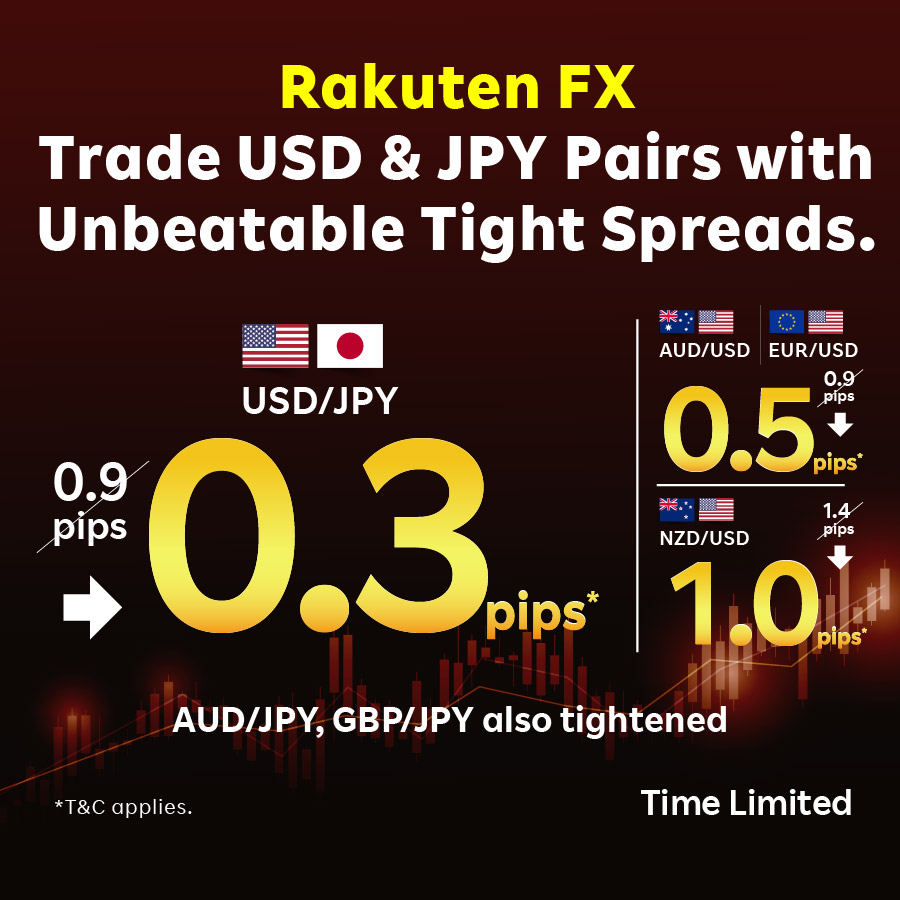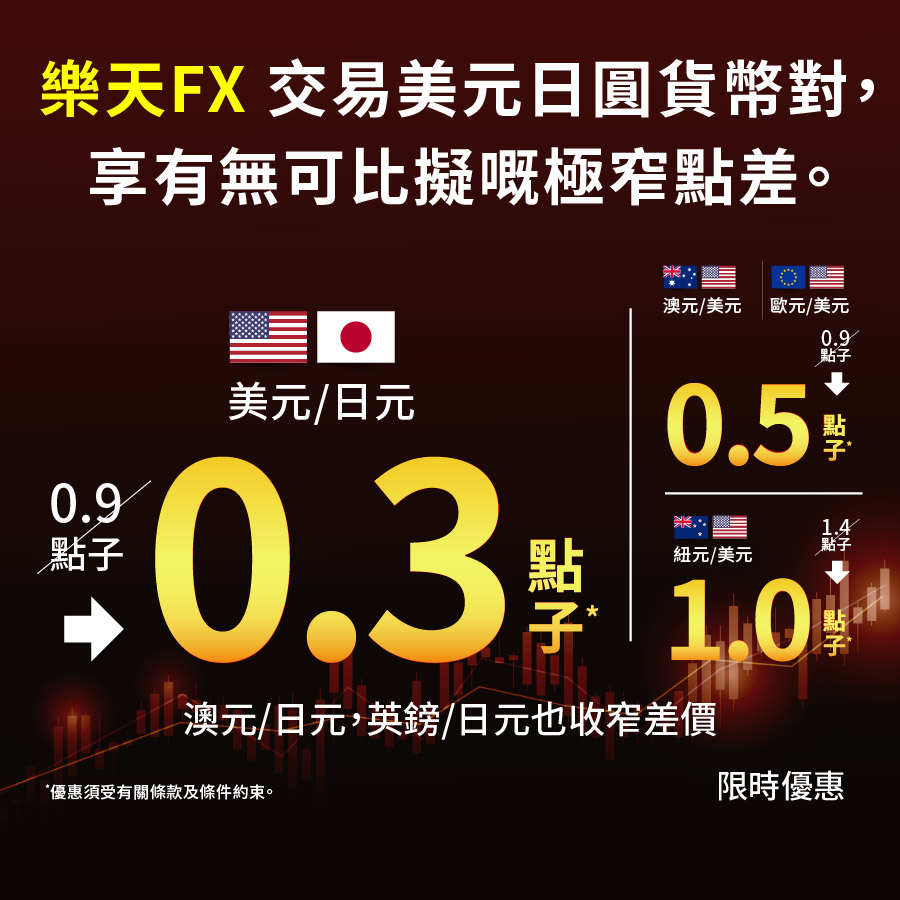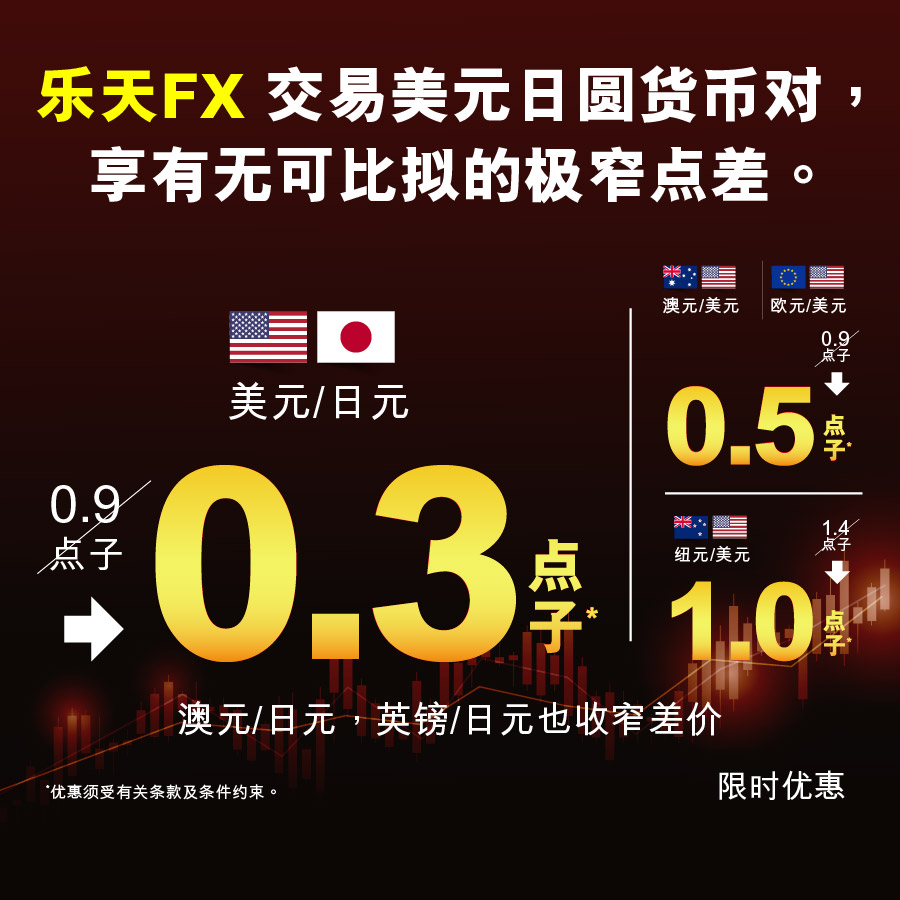Forex News

- Silver gains strong follow-through positive traction and hits a fresh all-time peak on Monday.
- The overbought RSI on hourly/daily charts warrants caution before placing fresh bullish bets.
- The broader technical setup backs the case for an extension of a well-established uptrend.
Silver (XAG/USD) prolongs its recent well-established uptrend and climbs to a fresh record high, around the $69.45 area, during the Asian session. Moreover, the broader technical setup seems tilted firmly in favor of bullish traders and suggests that the path of least resistance for the white metal remains to the upside.
Against the backdrop of repeated rebounds from the 100-hour Simple Moving Average (SMA) over the past two weeks or so, last week's breakout through the $66.40-$66.50 horizontal resistance was seen as a key trigger for the XAG/USD bulls. A subsequent strength beyond the $67.20-$67.25 region last Friday validates the near-term positive outlook. The white metal currently trades around the $69.25 area, up 3% for the day.
Meanwhile, the Relative Strength Index (RSI) on hourly/daily charts sits above the 70 mark, signaling stretched conditions that could prompt a pause. The 100-hour SMA climbs to $65.57, with price holding well above it, keeping the near-term trend biased upward. Moreover, the Moving Average Convergence Divergence (MACD) stands at 0.19 in positive territory and continues to rise, suggesting strengthening bullish momentum.
Buyers would retain control while XAG/USD remains above the rising 100-period SMA, and a pullback toward $65.57 would meet dynamic support. The MACD staying positive supports the bullish tone, while an overbought RSI suggests consolidation could precede further gains. A decisive continuation above intraday highs could extend the advance, whereas failure to hold above the average would open room for a deeper retracement.
(The technical analysis of this story was written with the help of an AI tool)
(This story was corrected on December 22 at 07:36 GMT to say in the second bullet point that the overbought RSI, not overnight, on hourly/daily charts warrants caution before placing fresh bullish bets.)
XAG/USD 1-hour chart
Silver FAQs
Silver is a precious metal highly traded among investors. It has been historically used as a store of value and a medium of exchange. Although less popular than Gold, traders may turn to Silver to diversify their investment portfolio, for its intrinsic value or as a potential hedge during high-inflation periods. Investors can buy physical Silver, in coins or in bars, or trade it through vehicles such as Exchange Traded Funds, which track its price on international markets.
Silver prices can move due to a wide range of factors. Geopolitical instability or fears of a deep recession can make Silver price escalate due to its safe-haven status, although to a lesser extent than Gold's. As a yieldless asset, Silver tends to rise with lower interest rates. Its moves also depend on how the US Dollar (USD) behaves as the asset is priced in dollars (XAG/USD). A strong Dollar tends to keep the price of Silver at bay, whereas a weaker Dollar is likely to propel prices up. Other factors such as investment demand, mining supply – Silver is much more abundant than Gold – and recycling rates can also affect prices.
Silver is widely used in industry, particularly in sectors such as electronics or solar energy, as it has one of the highest electric conductivity of all metals – more than Copper and Gold. A surge in demand can increase prices, while a decline tends to lower them. Dynamics in the US, Chinese and Indian economies can also contribute to price swings: for the US and particularly China, their big industrial sectors use Silver in various processes; in India, consumers’ demand for the precious metal for jewellery also plays a key role in setting prices.
Silver prices tend to follow Gold's moves. When Gold prices rise, Silver typically follows suit, as their status as safe-haven assets is similar. The Gold/Silver ratio, which shows the number of ounces of Silver needed to equal the value of one ounce of Gold, may help to determine the relative valuation between both metals. Some investors may consider a high ratio as an indicator that Silver is undervalued, or Gold is overvalued. On the contrary, a low ratio might suggest that Gold is undervalued relative to Silver.

- Australian Dollar gains ground amid cautious sentiment surrounding the RBA policy stance.
- The People’s Bank of China left one- and five-year Loan Prime Rates unchanged at 3.00% and 3.50%, respectively.
- Fed’s Hammack said policy is well-positioned to pause and assess the impact of 75-basis-point rate cuts.
The Australian Dollar (AUD) holds gains against the US Dollar (USD) on Monday after the People’s Bank of China (PBOC), China's central bank, announced to leave its Loan Prime Rates (LPRs) unchanged. The one- and five-year LPRs were at 3.00% and 3.50%, respectively.
Traders will likely focus on the Reserve Bank of Australia’s (RBA) Meeting Minutes due on Tuesday, for clues on the central bank’s policy outlook and its assessment of inflationary pressures. As of December 18, the ASX 30-Day Interbank Cash Rate Futures February 2026 contract was trading at 96.34, implying a 27% probability of a rate increase to 3.85% at the next RBA Board meeting.
US Dollar breaks three-day winning streak despite cautious Fedspeak
- The US Dollar Index (DXY), which measures the value of the US Dollar against six major currencies, is losing ground and trading around 98.60 at the time of writing. Traders await the US Gross Domestic Product Annualized for the third quarter due on Tuesday.
- Federal Reserve Bank of Cleveland President Beth Hammack said on Sunday that monetary policy is in a good position to pause and assess the effects of the 75-basis-point (bps) rate cuts on the economy during the first quarter, according to Bloomberg.
- The University of Michigan reported on Friday that the Consumer Sentiment Index was revised down to 52.9 in December from the previous reading of 53.3. Consumer Expectations Index fell to 54.6 from 55.0. Meanwhile, One-year Inflation Expectations were revised up to 4.2% from 4.1% in both the initial estimate and the prior month.
- The Summary of Economic Projections, or so-called "dot plot," indicated a median expectation of only one additional rate cut in 2026. The CME FedWatch tool shows a 79.0% probability of rates being held at the Fed’s January meeting, up from 75.6% a week earlier. Meanwhile, the likelihood of a 25-basis-point rate cut has fallen to 21.0% from 24.4% a week ago.
- The US Bureau of Labor Statistics (BLS) released on Thursday that the US Consumer Price Index (CPI) eased to 2.7% in November. This reading came in below the market consensus of 3.1%. Meanwhile, the US core CPI, which excludes volatile food and energy prices, rose by 2.6%, missing the expectation of 3.0%. This figure marks the slowest pace since 2021.
- US President Donald Trump said on Thursday that the next chairman of the Federal Reserve (Fed) will be someone who believes in lower interest rates "by a lot." Trump further noted that he will soon announce a successor to current Fed Chair Jerome Powell.
- Fed Governor Christopher Waller, who is under consideration to become chair of the central bank, reiterated his dovish stance on interest rates during a CNBC forum. “Because inflation is still elevated, we can take our time - there’s no rush to get down. We can steadily bring the policy rate down toward neutral,” Waller said.
- Australia’s Consumer Inflation Expectations, which rose to 4.7% in December from November’s three-month low of 4.5%, support the Reserve Bank of Australia’s (RBA) hawkish stance.
Australian Dollar hovers around nine-day EMA above 0.6600
The AUD/USD pair is trading below 0.6620 on Monday. The technical analysis of the daily chart shows the pair is hovering around the lower ascending channel boundary, indicating the broader trend remains bullish with support holding, while further price action may provide clearer direction. The 14-day Relative Strength Index (RSI) stands at 57.05, reflecting neutral-to-bullish conditions and building momentum. It remains above the midline, keeping bulls in control.
The nine-day Exponential Moving Average (EMA) is trending higher and sits just above the spot, capping upside attempts. However, it has flattened over the past session, signaling sideways short-term momentum. The AUD/USD pair maintains a modest uptrend as the nine-day EMA slope remains positive while price consolidates just below the average.
The AUD/USD pair is hovering near the nine-day EMA at 0.6620. A sustained break above this level would bolster short-term momentum, opening the way toward the three-month high at 0.6685 and then 0.6707, the highest since October 2024. On the downside, a decisive break below the ascending channel could increase downside pressure, exposing the six-month low near 0.6414, marked on August 21.

Australian Dollar Price Today
The table below shows the percentage change of Australian Dollar (AUD) against listed major currencies today. Australian Dollar was the strongest against the US Dollar.
| USD | EUR | GBP | JPY | CAD | AUD | NZD | CHF | |
|---|---|---|---|---|---|---|---|---|
| USD | -0.05% | -0.15% | -0.20% | -0.04% | -0.26% | -0.20% | -0.06% | |
| EUR | 0.05% | -0.10% | -0.15% | 0.04% | -0.19% | -0.13% | -0.01% | |
| GBP | 0.15% | 0.10% | -0.04% | 0.11% | -0.12% | -0.03% | 0.09% | |
| JPY | 0.20% | 0.15% | 0.04% | 0.18% | -0.05% | 0.03% | 0.16% | |
| CAD | 0.04% | -0.04% | -0.11% | -0.18% | -0.23% | -0.15% | -0.02% | |
| AUD | 0.26% | 0.19% | 0.12% | 0.05% | 0.23% | 0.08% | 0.20% | |
| NZD | 0.20% | 0.13% | 0.03% | -0.03% | 0.15% | -0.08% | 0.12% | |
| CHF | 0.06% | 0.01% | -0.09% | -0.16% | 0.02% | -0.20% | -0.12% |
The heat map shows percentage changes of major currencies against each other. The base currency is picked from the left column, while the quote currency is picked from the top row. For example, if you pick the Australian Dollar from the left column and move along the horizontal line to the US Dollar, the percentage change displayed in the box will represent AUD (base)/USD (quote).
Australian Dollar FAQs
One of the most significant factors for the Australian Dollar (AUD) is the level of interest rates set by the Reserve Bank of Australia (RBA). Because Australia is a resource-rich country another key driver is the price of its biggest export, Iron Ore. The health of the Chinese economy, its largest trading partner, is a factor, as well as inflation in Australia, its growth rate and Trade Balance. Market sentiment – whether investors are taking on more risky assets (risk-on) or seeking safe-havens (risk-off) – is also a factor, with risk-on positive for AUD.
The Reserve Bank of Australia (RBA) influences the Australian Dollar (AUD) by setting the level of interest rates that Australian banks can lend to each other. This influences the level of interest rates in the economy as a whole. The main goal of the RBA is to maintain a stable inflation rate of 2-3% by adjusting interest rates up or down. Relatively high interest rates compared to other major central banks support the AUD, and the opposite for relatively low. The RBA can also use quantitative easing and tightening to influence credit conditions, with the former AUD-negative and the latter AUD-positive.
China is Australia’s largest trading partner so the health of the Chinese economy is a major influence on the value of the Australian Dollar (AUD). When the Chinese economy is doing well it purchases more raw materials, goods and services from Australia, lifting demand for the AUD, and pushing up its value. The opposite is the case when the Chinese economy is not growing as fast as expected. Positive or negative surprises in Chinese growth data, therefore, often have a direct impact on the Australian Dollar and its pairs.
Iron Ore is Australia’s largest export, accounting for $118 billion a year according to data from 2021, with China as its primary destination. The price of Iron Ore, therefore, can be a driver of the Australian Dollar. Generally, if the price of Iron Ore rises, AUD also goes up, as aggregate demand for the currency increases. The opposite is the case if the price of Iron Ore falls. Higher Iron Ore prices also tend to result in a greater likelihood of a positive Trade Balance for Australia, which is also positive of the AUD.
The Trade Balance, which is the difference between what a country earns from its exports versus what it pays for its imports, is another factor that can influence the value of the Australian Dollar. If Australia produces highly sought after exports, then its currency will gain in value purely from the surplus demand created from foreign buyers seeking to purchase its exports versus what it spends to purchase imports. Therefore, a positive net Trade Balance strengthens the AUD, with the opposite effect if the Trade Balance is negative.
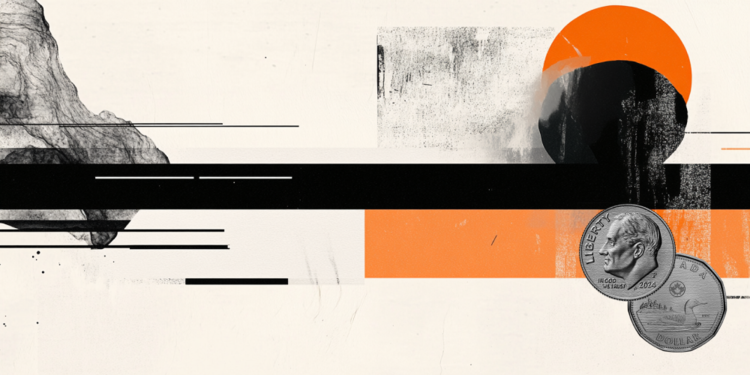
- USD/CAD demonstrates strength near 1.3800 amid weakness in the Canadian Dollar.
- Canadian Retail Sales declined unexpectedly by 0.2% in October.
- Investors await the preliminary US Q3 GDP data.
The USD/CAD pair trades firmly near Friday’s high around 1.3800 during the early European trading session on Monday. The Loonie pair demonstrates strength as the Canadian Dollar (CAD) underperforms amid growing household spending concerns.
On Friday, Statistics Canada reported that Retail Sales, a key measure of consumer spending, declined 0.2% on a month in October, while they were expected to remain flat. In September, the consumer spending measure also declined by 0.9%.
Falling household demand could underpin the need for more interest rate cuts by the Bank of Canada (BoC) in the near term.
Meanwhile, the US Dollar (USD) trades slightly lower ahead of the flash United States (US) Q3 Gross Domestic Product (GDP) data, which will be released on Tuesday. The US economy is expected to have grown at a moderate pace of 3.2%.
USD/CAD technical analysis
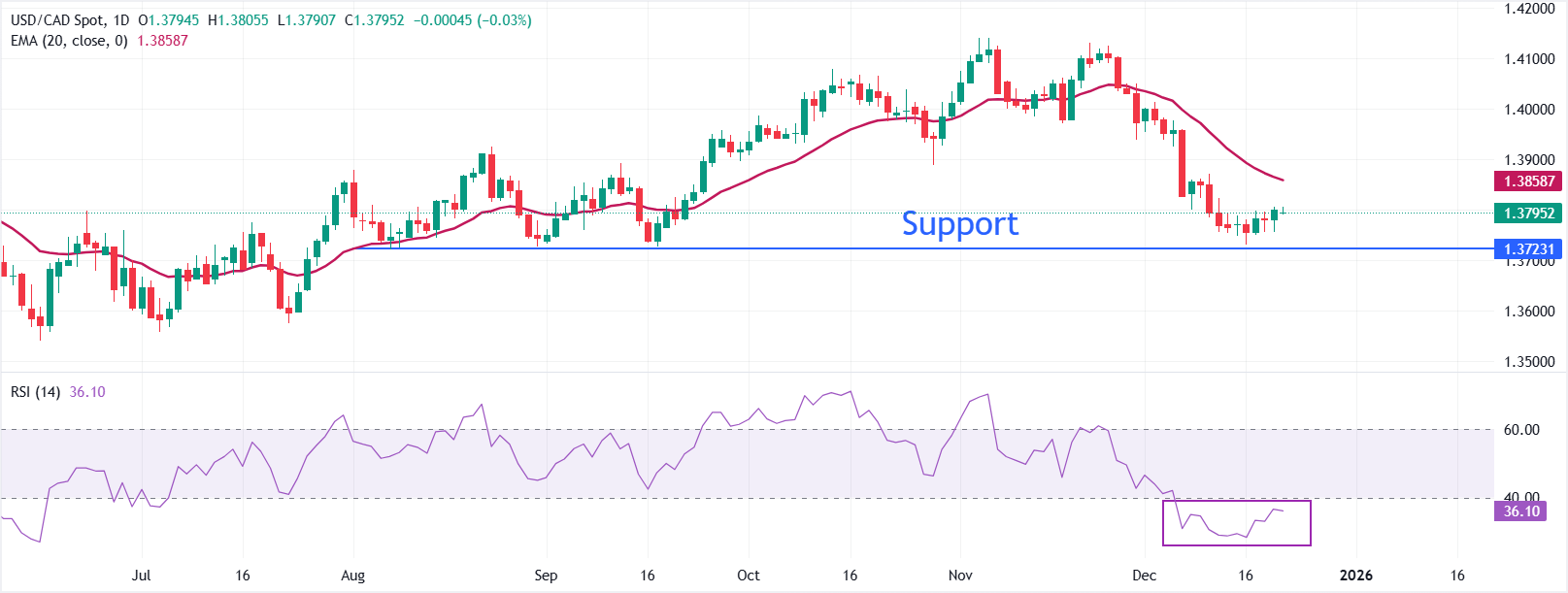
USD/CAD clings to gains near 1.3800 on Monday. The pair holds beneath a descending 20-day Exponential Moving Average (EMA), keeping the short-term bias tilted lower as bounces remain contained by the average. The EMA’s steady downturn underscores persistent supply on upticks. The 14-day Relative Strength Index (RSI) sits at 36, near oversold after a modest bounce from last week’s extremes, while momentum remains fragile.
A sustained recovery would require a daily close above the 20-day EMA to ease downside pressure that could increase the odds of an upside move towards the round-level figure of 1.3900. Until then, the downbeat setup persists and could strengthen if the spot breaks below the August 7 low of 1.3720.
(The technical analysis of this story was written with the help of an AI tool.)
Economic Indicator
Gross Domestic Product Annualized
The real Gross Domestic Product (GDP) Annualized, released quarterly by the US Bureau of Economic Analysis, measures the value of the final goods and services produced in the United States in a given period of time. Changes in GDP are the most popular indicator of the nation’s overall economic health. The data is expressed at an annualized rate, which means that the rate has been adjusted to reflect the amount GDP would have changed over a year’s time, had it continued to grow at that specific rate. Generally speaking, a high reading is seen as bullish for the US Dollar (USD), while a low reading is seen as bearish.
Read more.Next release: Tue Dec 23, 2025 13:30 (Prel)
Frequency: Quarterly
Consensus: 3.2%
Previous: 3.8%
Source: US Bureau of Economic Analysis
The US Bureau of Economic Analysis (BEA) releases the Gross Domestic Product (GDP) growth on an annualized basis for each quarter. After publishing the first estimate, the BEA revises the data two more times, with the third release representing the final reading. Usually, the first estimate is the main market mover and a positive surprise is seen as a USD-positive development while a disappointing print is likely to weigh on the greenback. Market participants usually dismiss the second and third releases as they are generally not significant enough to meaningfully alter the growth picture.

- WTI price climbs to near $57.65 in Monday’s early European session, up 1.12% on the day.
- Officials said the US had intercepted an oil tanker in international waters off the coast of Venezuela.
- Fed rate cut bets might help limit the WTI’s losses.
West Texas Intermediate (WTI), the US crude oil benchmark, is trading around $57.65 during the early European trading hours on Monday. The WTI price rises after US President Donald Trump said that he will not rule out war with Venezuela, raising fresh supply uncertainty. Traders brace for the release of the American Petroleum Institute (API) crude oil stockpiles report on Tuesday for fresh impetus.
NBC reported on Sunday that the US is still in pursuit of a third oil tanker near Venezuela as Trump intensifies an oil blockade on Nicolás Maduro’s government. Another official affirmed that the tanker was under sanctions but reiterated that it had not yet been boarded and that interceptions may take several forms, including sailing or flying near vessels of concern.
"The market is waking up to the fact that the Trump administration is taking a hardline approach to the Venezuelan oil trade," said June Goh, senior oil market analyst at Sparta Commodities.
On the other hand, the growing expectation that the US Federal Reserve (Fed) will deliver further interest rate cuts after signs of softer US inflation and cooler jobs reports could weigh on the US Dollar (USD) and boost the USD-denominated commodity price.
Financial markets are pricing in nearly a 21.0% odds the Fed will cut interest rates at its next meeting in January, after it reduced them by a quarter-point at each of its last three meetings, according to the CME FedWatch tool.
WTI Oil FAQs
WTI Oil is a type of Crude Oil sold on international markets. The WTI stands for West Texas Intermediate, one of three major types including Brent and Dubai Crude. WTI is also referred to as “light” and “sweet” because of its relatively low gravity and sulfur content respectively. It is considered a high quality Oil that is easily refined. It is sourced in the United States and distributed via the Cushing hub, which is considered “The Pipeline Crossroads of the World”. It is a benchmark for the Oil market and WTI price is frequently quoted in the media.
Like all assets, supply and demand are the key drivers of WTI Oil price. As such, global growth can be a driver of increased demand and vice versa for weak global growth. Political instability, wars, and sanctions can disrupt supply and impact prices. The decisions of OPEC, a group of major Oil-producing countries, is another key driver of price. The value of the US Dollar influences the price of WTI Crude Oil, since Oil is predominantly traded in US Dollars, thus a weaker US Dollar can make Oil more affordable and vice versa.
The weekly Oil inventory reports published by the American Petroleum Institute (API) and the Energy Information Agency (EIA) impact the price of WTI Oil. Changes in inventories reflect fluctuating supply and demand. If the data shows a drop in inventories it can indicate increased demand, pushing up Oil price. Higher inventories can reflect increased supply, pushing down prices. API’s report is published every Tuesday and EIA’s the day after. Their results are usually similar, falling within 1% of each other 75% of the time. The EIA data is considered more reliable, since it is a government agency.
OPEC (Organization of the Petroleum Exporting Countries) is a group of 12 Oil-producing nations who collectively decide production quotas for member countries at twice-yearly meetings. Their decisions often impact WTI Oil prices. When OPEC decides to lower quotas, it can tighten supply, pushing up Oil prices. When OPEC increases production, it has the opposite effect. OPEC+ refers to an expanded group that includes ten extra non-OPEC members, the most notable of which is Russia.

Here is what you need to know on Monday, December 22:
Gold gathers bullish momentum to the holiday-shortened week and trades at a new record-high above $4,400. The economic calendar will not offer any high-tier data releases on Monday, allowing investors to react to changes in risk perception.
US Dollar Price Last 7 Days
The table below shows the percentage change of US Dollar (USD) against listed major currencies last 7 days. US Dollar was the strongest against the Japanese Yen.
| USD | EUR | GBP | JPY | CAD | AUD | NZD | CHF | |
|---|---|---|---|---|---|---|---|---|
| USD | 0.21% | -0.10% | 0.99% | 0.18% | 0.28% | 0.52% | -0.14% | |
| EUR | -0.21% | -0.30% | 0.76% | -0.03% | 0.09% | 0.31% | -0.35% | |
| GBP | 0.10% | 0.30% | 1.18% | 0.28% | 0.40% | 0.62% | -0.04% | |
| JPY | -0.99% | -0.76% | -1.18% | -0.79% | -0.69% | -0.47% | -0.91% | |
| CAD | -0.18% | 0.03% | -0.28% | 0.79% | 0.10% | 0.34% | -0.17% | |
| AUD | -0.28% | -0.09% | -0.40% | 0.69% | -0.10% | 0.21% | -0.44% | |
| NZD | -0.52% | -0.31% | -0.62% | 0.47% | -0.34% | -0.21% | -0.66% | |
| CHF | 0.14% | 0.35% | 0.04% | 0.91% | 0.17% | 0.44% | 0.66% |
The heat map shows percentage changes of major currencies against each other. The base currency is picked from the left column, while the quote currency is picked from the top row. For example, if you pick the US Dollar from the left column and move along the horizontal line to the Japanese Yen, the percentage change displayed in the box will represent USD (base)/JPY (quote).
Reports of Israel planning to attack Iran on growing concerns about Iran reconstituting nuclear enrichment sites and expanding its ballistic missile program cause markets to adopt a cautious stance early Monday. Citing four former US officials familiar with the development, NBC news reported that Israeli Prime Minister Benjamin Netanyahu is expected to meet US President Donald Trump later this month to explain why they need to take military action against Iran again. After rising above 1% in the previous week, Gold turned north in the Asian session and was last seen trading at $4,405, rising more than 1.5% on the day.
Meanwhile, US stock index futures trade marginally higher after Wall Street's main indexes closed in positive territory on Friday and the US Dollar (USD) Index stays in a consolidation phase above 98.50 following the recovery seen in the second half of last week. On Tuesday, the US Bureau of Economic Analysis will publish the Gross Domestic Product data for the third quarter.
EUR/USD corrected lower following the rally seen in the first half of the previous week and closed in negative territory to snap a three-week winning streak. The pair holds steady in the European morning on Monday and trades in a tight channel above 1.1700.
Escalating tensions in the Middle East seem to be causing oil prices to rise at the beginning of the week. At the time of press, the Barrel of West Texas Intermediate was up more than 1% on the day at $57.15.
The People’s Bank of China (PBOC) announced early Monday that it left its one-year and five-year Loan Prime Rates (LPRs) unchanged at 3.00% and 3.50%, respectively. After posting marginal gains on Thursday and Friday, AUD/USD gains traction and trades near 0.6630 to start the European session.
GBP/USD ended the previous week virtually unchanged despite the volatile action see in the immediate aftermath of the Bank of England's (BoE) policy announcements. The pair edges slightly higher early Monday and trades near 1.3400.
USD/JPY corrects lower after rising nearly 1.5% on Friday and trades in negative territory below 157.50.
Gold FAQs
Gold has played a key role in human’s history as it has been widely used as a store of value and medium of exchange. Currently, apart from its shine and usage for jewelry, the precious metal is widely seen as a safe-haven asset, meaning that it is considered a good investment during turbulent times. Gold is also widely seen as a hedge against inflation and against depreciating currencies as it doesn’t rely on any specific issuer or government.
Central banks are the biggest Gold holders. In their aim to support their currencies in turbulent times, central banks tend to diversify their reserves and buy Gold to improve the perceived strength of the economy and the currency. High Gold reserves can be a source of trust for a country’s solvency. Central banks added 1,136 tonnes of Gold worth around $70 billion to their reserves in 2022, according to data from the World Gold Council. This is the highest yearly purchase since records began. Central banks from emerging economies such as China, India and Turkey are quickly increasing their Gold reserves.
Gold has an inverse correlation with the US Dollar and US Treasuries, which are both major reserve and safe-haven assets. When the Dollar depreciates, Gold tends to rise, enabling investors and central banks to diversify their assets in turbulent times. Gold is also inversely correlated with risk assets. A rally in the stock market tends to weaken Gold price, while sell-offs in riskier markets tend to favor the precious metal.
The price can move due to a wide range of factors. Geopolitical instability or fears of a deep recession can quickly make Gold price escalate due to its safe-haven status. As a yield-less asset, Gold tends to rise with lower interest rates, while higher cost of money usually weighs down on the yellow metal. Still, most moves depend on how the US Dollar (USD) behaves as the asset is priced in dollars (XAU/USD). A strong Dollar tends to keep the price of Gold controlled, whereas a weaker Dollar is likely to push Gold prices up.

- NZD/USD jumps to near 0.5770 as the New Zealand Dollar gains on a risk-on mood.
- Upbeat NZ Q3 GDP data failed to lift RBNZ hawkish bets.
- The US Dollar drops despite slim Fed dovish bets for the January meeting.
The NZD/USD pair trades 0.25% higher to near 0.5770 during the early European trading session on Monday. The Kiwi pair regains ground after revisiting an almost three-week low near 0.5736 on Friday amid improved risk sentiment.
However, the upside in the New Zealand Dollar (NZD) seems to be capped as market expectations for a Reserve Bank of New Zealand (RBNZ) interest rate hike have diminished, despite the release of the better-than-projected New Zealand (NZ) Q3 Gross Domestic Product (GDP) data.
The probability of the RBNZ hiking its Official Cash Rate (OCR) in the July 2026 meeting has diminished to 40% from 50% seen before the Q3 GDP data release.
Stats NZ reported on Thursday that the economy grew at a faster pace of 1.1% compared to estimates of 0.9%. In the second quarter, the economy declined by 1%.
Meanwhile, a slight corrective move in the US Dollar (USD) has also strengthened the Kiwi pair. The US Dollar Index (DXY) trades slightly lower to near 98.60, even as traders remain confident that the Federal Reserve (Fed) will not cut interest rates in the January policy meeting.
NZD USD technical analysis

NZD/USD trades higher around 0.5769 at the start of the week. The pair holds above the rising 20-day Exponential Moving Average (EMA) at 0.5757, preserving a short-term upside bias. The 20-day EMA has been tilting higher for several sessions, continuing to support dips. RSI at 55 (neutral) is nudging up, keeping momentum mildly positive.
A sustained hold above the 20-day EMA would keep the recovery intact. The path for further gains would open if the price breaks above the December 11 high at 0.5832. Whereas, the price could lose ground if it breaks below Friday's low of 0.5735.
With the Relative Strength Index (RSI) shy of 60 and away from overbought, bulls have room to press higher. A retreat toward the 50 midline would warn of loss of traction.
(The technical analysis of this story was written with the help of an AI tool.)
Economic Indicator
Gross Domestic Product (QoQ)
The Gross Domestic Product (GDP), released by Statistics New Zealand on a quarterly basis, is a measure of the total value of all goods and services produced in New Zealand during a given period. The GDP is considered as the main measure of New Zealand’s economic activity. The QoQ reading compares economic activity in the reference quarter to the previous quarter. Generally, a high reading is seen as bullish for the New Zealand Dollar (NZD), while a low reading is seen as bearish.
Read more.Last release: Wed Dec 17, 2025 21:45
Frequency: Quarterly
Actual: 1.1%
Consensus: 0.9%
Previous: -0.9%
Source: Stats NZ
The Gross Domestic Product (GDP), released by Statistics New Zealand, highlights the overall economic performance on a quarterly basis. The gauge has a significant influence on the Reserve Bank of New Zealand’s (RBNZ) monetary policy decision, in turn affecting the New Zealand dollar. A rise in the GDP rate signifies improvement in the economic conditions, which calls for tighter monetary policy, while a drop suggests deterioration in the activity. An above-forecast GDP reading is seen as NZD bullish.
Forex Market News
Our dedicated focus on forex news and insights empowers you to capitalise on investment opportunities in the dynamic FX market. The forex landscape is ever-evolving, characterised by continuous exchange rate fluctuations shaped by vast influential factors. From economic data releases to geopolitical developments, these events can sway market sentiment and drive substantial movements in currency valuations.
At Rakuten Securities Hong Kong, we prioritise delivering timely and accurate forex news updates sourced from reputable platforms like FXStreet. This ensures you stay informed about crucial market developments, enabling informed decision-making and proactive strategy adjustments. Whether you’re monitoring forex forecasts, analysing trading perspectives, or seeking to capitalise on emerging trends, our comprehensive approach equips you with the insights needed to navigate the FX market effectively.
Stay ahead with our comprehensive forex news coverage, designed to keep you informed and prepared to seize profitable opportunities in the dynamic world of forex trading.




